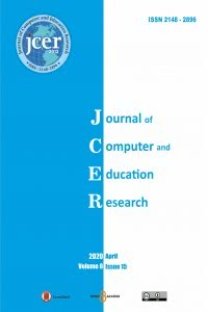Ortaya Çıkan Modelleme Yaklaşımıyla Parantez Kullanımının Anlamlandırılma Süreci
The Conceptualisation Process of Parenthesis with the Emergent Modelling Perspective
___
- Biccard, P., & Wessels, D. (2017). Developing mathematisation practices in primary mathematics teaching through didactisation-based teacher development. African Journal of Research in Mathematics, Science and Technology Education, 21(1), 61-73,
- Dewey, J. (1938). Deneyim ve eğitim (Çev. S. Akıllı) Ankara: ODTÜ Geliştirme Vakfı Yayıncılık ve İletişim A.Ş.
- Doerr, H., & English, L. D. (2003). A modeling perspective on students’ mathematical reasoning about data. Journal of Research in Mathematics Education, 34(2), 110-136.
- Duval, R. (2006). A cognitive analysis of problems of comprehension in a learning of mathematics. Educational Studies in Mathematics, 61, 103–131.
- Erbaş, A. K., Çetinkaya, B., Alacacı, C., Çakıroğlu, E., Aydoğan Yenmez, A., Şen Zeytun, A., Korkmaz, H., Kertil, M., Didiş, M. G., Baş, S., & Şahin, Z. (2016). Lise matematik konuları için günlük hayattan modelleme soruları. Ankara: Türkiye Bilimler Akademisi.
- Gunnarsson, R., Sönnerhed, W. W., & Hernell, B. (2016). Does it help to use mathematically superfluous brackets when teaching the rules for the order of operations?. Educational Studies in Mathematics, 92, 91–105.
- Günay, D. (2008). Görsel okuryazarlık ve imgenin anlamlandırılması. Süleyman Demirel Üniversitesi Güzel Sanatlar Fakültesi Dergisi, 1(1), 1-29.
- Hiebert, J., & Lefevre, P. (1986). Conceptual and procedural knowledge in mathematics: An introductory analysis. In. J. Hiebert (Ed.), Conceptual and Procedural Knowledge: The case of mathematics. Hillsdale, N. Jersey: Lawrence Erlbaum Associates.
- Kertil, M., Çetinkaya B., Erbaş A. K., Çakıroğlu E.,(2016). Matematik eğitiminde matematiksel modelleme. E. Bingölbali, S. Arslan ve İ. Ö. Zembat (Ed.), Matematik eğitiminde teoriler içinde (ss. 539–563), Ankara: Pegem Akademi Yayıncılık.
- Lange, J. de (1994). Assessment: No change without problems. In: T.A. Romberg (Ed) Reform in School Mathematics and Authentic Assessment. SUNY Press, Albany NY, pp 87-172.
- Lesh, R., & Doerr, H. (2003). Foundations of a models and modeling perspective on mathematics teaching, learning, and problem solving. In R. Lesh & H. Doerr (Eds.), Beyond Constructivism: Models and Modeling Perspective on Mathematics Problem Solving, Learning, and Teaching (pp. 3 - 33). Mahwah, NJ: Lawrence Erlbaum Associates.
- Lesh, R., & Zawojewski, J. S. (2007). Problem solving and modeling. In F. Lester (Ed.), Second handbook of research on mathematics teac hing and learning (pp. 763–804). Greenwich, CT: Information Age Publishing.
- Millî Eğitim Bakanlığı [MEB]. (2018). İlköğretim matematik dersi programı. Ankara: MEB.
- Moustakas, C. (1994). Phenomenological research methods. Thousand Oaks, CA: Sage.
- Öçal, M. F., İpek, A. S., Özdemir, E. & Kar, T. (2018). Ortaokul öğrencilerinin aritmetiksel ifadelere yönelik problem kurma becerilerinin işlem önceliği bağlamında incelenmesi. Türk Bilgisayar ve Matematik Eğitimi Dergisi, 9 (2), 170-191.
- Selvi, K. (2008). Phenomenological Approach in Education. In: A.T. Tymieniecka (Ed) Education in human creative existential planning. Analecta Husserliana (The Yearbook Of Phenomenological Research), vol 95. Springer, Dordrecht.
- Swetz, F., & Hartzer, J. S. (1991). Mathematical modeling in the secondary school curriculum: A resource guide of classroom exercises. Reston, VA: NCTM.
- Tural-Sönmez, M. (2017). Matematiksel modelleme problemlerinin yapılandırılması üzerine tasarım tabanlı inceleme: finansal içerik örneği. Journal of Computer and Education Research, 5 (10), 218-240. DOI: 10.18009/jcer.307314
- Türker-Biber, B., & Yetkin-Özdemir, İ. E. (2015). Matematik öğretiminde matematiksel modelleme yaklaşımı. Cito Eğitim: Kuram ve Uygulama, 27, 45-56.
- Uça, S. (2010). Matematik öğretiminde işlem sırasının kavratılmasında yeni bir yaklaşım: Mnemoni (Yayınlanmamış yüksek lisans tezi). Adnan Menderes Üniversitesi, Sosyal Bilimler Enstitüsü, Aydın.
- Yayın Aralığı: 2
- Başlangıç: 2013
- Yayıncı: Tamer KUTLUCA
An Examination of Middle School 7th Grade Students’ Mathematical Abstraction Processes
Elif KILIÇOĞLU, Abdullah KAPLAN
Ebru KÜKEY, Recep ASLANER, Tayfun TUTAK
İlkokulda STEM: Öğrencilerin Kariyer İlgileri ve Tutumları
İlkokul 3. Sınıf Fen Bilimleri Ders Kitabında: Dilbilgisel Eğretileme Olarak Adlaştırma
The Scale of Happiness Strategies for Children’s used by Preschool Teachers
Özkan SAPSAĞLAM, Ali ERYILMAZ, Ayça Bahar BAKKALOĞLU
Teknoloji Destekli Probleme Dayalı Öğretim Uygulamalarının Matematik Başarısına Etkisi
Yücel ÇETİN, Şeref MİRASYEDİOĞLU
Mathematics Teachers’ Views on Mathematical Thinking
Emine Nur ÜNVEREN BİLGİÇ, Ayşe Zeynep AZAK
Phenomenon-Based Learning for Teaching ICT Subject through other Subjects in Primary Schools
Karzan WAKIL, Rupak RAHMAN, Dana HASAN, Pakhshan MAHMOOD, Trifa JALAL
